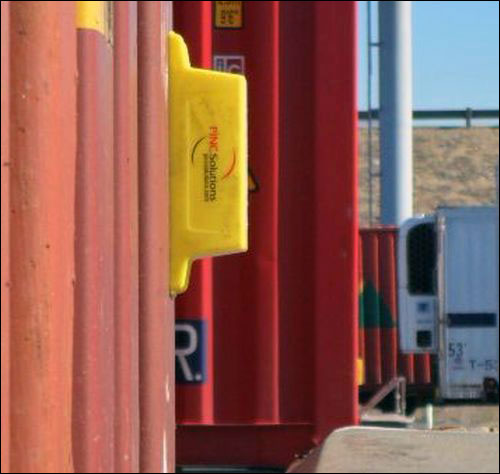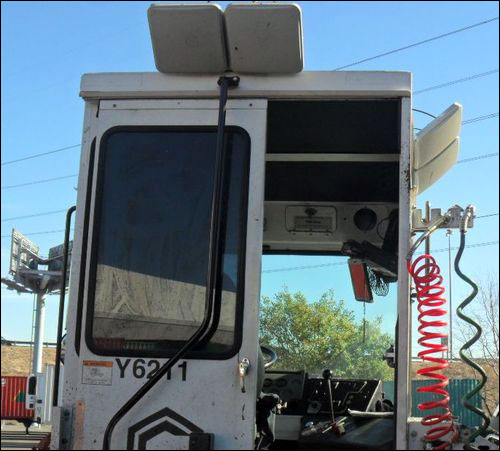Third-party logistics provider DSC Logistics is gaining efficiency and lowering costs at its site in Mira Loma, Calif., using a ultrahigh-frequency (UHF) radio frequency identification system provided by PINC Solutions. PINC’s Yard Hound system, which was taken live a year ago, not only eliminates the need for staff members to search for trailers, but also enables carriers and shippers to access data regarding shipments’ locations via the Internet.
The supply chain management company’s Mira Loma Logistics Center comprises three shipping and storage facilities, all sharing a single yard in which loaded and empty trailers are stored prior to being unloaded or shipped elsewhere. Not only are the trailers managed across three facilities, but their contents belong to one of about 20 customers, with the trailers themselves managed by one of multiple freight companies. Most of the approximately 200 trailers located onsite at any given time contain perishable food products, and have a short turnaround time—between one and three days. Trailers are commonly unloaded upon arriving from the Port of Long Beach, and their contents are stored and then shipped at the DSC Logistics facility.

To record the trailers’ arrival and departure times, as well as their locations while within the yard, the company had developed a manual yard-management system that depended on paper and pen, as well as a Microsoft Excel spreadsheet. This, however, was a time-consuming process, the company reports, requiring workers on each shift to spend approximately an hour visually inspecting the containers within the yard, and writing down each container’s serial number and location, after which the office staff spent another hour or so reconciling the handwritten information with the data in the system. If a freight carrier wished to learn the status of its trailers—whether, for example, they had been received at the yard, or had been shipped from it, or whether they had yet been unloaded—that company had to await a periodic e-mail from the facility, make frequent phone calls or request that data be extracted from the electronic record and e-mailed to its address.
During the past year, the logistics center took on a large new client, resulting in an increased number of trailers entering and leaving the yard, and thus making yard management more complex. Therefore, DSC Logistics opted to try PINC’s Yard Hound solution, consisting of passive EPC Gen 2 UHF RFID tags placed on containers, readers installed on the yard trucks, and software to manage read data that could then be shared with operations, customers and freight companies via the Internet, according to Michael O’Reilly, DSC Logistics’ solutions manager and the project leader for this implementation.
DSC Logistics trialed the system at its yard for several months, after which, O’Reilly says, “We validated the cost savings we were anticipating, identified additional service benefits, and were ready to make a commitment to the technology and partnership with PINC.”
With the RFID-based system in place, some trailers that repeatedly come and go from the yard have a permanent Alien Technology RFID tag bolted to their exterior. Upon arriving at the yard, says Rafael Granato, PINC Solutions’ marketing communications manager, the trailers pass through the gate, where a PINC gate reader—consisting of a Motorola Solutions XR440 reader—interrogates the tag, links that tag ID number with data regarding the trailer and the customer, and displays that information for the gate guard on his PC. Having already received an update from the Yard Hound software pertaining to shipments expected for that day, the gate guard then presses prompts to indicate that the shipment is in order, and directs the driver as to where the trailer should be deposited.
For trailers new to the yard, the gate guard inputs data about each arriving trailer, such as its serial number and owner, and then reads a new tag on a Motorola desktop interrogator that links the RFID tag’s unique ID number with the trailer data. The tag, which has a magnetic backing, is temporarily attached to the front of the trailer, on the driver’s side. The driver then takes the trailer to its assigned spot within the yard. Once the trailer leaves the yard, the temporary tag is removed.
According to Granato, the yard is equipped with a transport vehicle known as the “yard goat,” on which a single Motorola XR450 RFID reader is installed—with a pair of antennas affixed to one side and to the back of the driver’s cab—as well as a GPS unit and a cellular radio. (The device can also transmit data via Wi-Fi, though it is not presently being used in that manner at DSC Logistics’ facility). When the truck is not carrying a load, the XR450 interrogator continually reads an RFID tag permanently installed on the back of the vehicle, near the rear antenna, and the cellular radio forwards that ID number to the back-end software, along with the vehicle’s GPS location. As the yard goat passes among trailers throughout the yard, the antennas on the side of the truck capture the ID numbers of other trailers’ tags. The GPS unit’s data—including the truck’s location, direction and speed—and the ID numbers are then sent to the back-end software, which updates each trailer’s location. In this way, if a trailer has been deposited in the yard and its specific location is not yet known, the system can receive data from the yard goat’s on-board reader device, and the software can instantly update the trailer’s exact location.

When the yard goat hooks up to a trailer, its own tag is covered, and the reader can no longer read the ID number, thereby indicating that the yard goat has picked up a load. The XR450 reader then interrogates the trailer tag, and the cellular radio forwards the trailer tag’s ID, along with the location information. Once the yard goat’s driver finishes dropping off a trailer somewhere within the yard, or at a dock door, the software updates the system with the latest location data. When the trailer is later shipped out of the yard, it passes the gate reader once more, which captures the tag ID and sends that information to the software, where the shipment status is changed to shipped.
At the California location, O’Reilly says, the PINC system has enabled the company to achieve savings by increasing the yard-goat drivers’ productivity, reducing average travel distance within the yard, streamlining communication between drivers and the shipping office, and eliminating the manual yard-check process. Another benefit, he adds, is the ability to share data with freight carriers and customers, which need simply log into the DSC Logistics’ PINC Web site, enter a password, access a dashboard displaying each trailer’s status (such as received, unloaded or shipped) and view its location as an icon on a yard map. The system can send notifications to customers, either via an update on their dashboard as they sign in, or via an e-mail indicating when a specific action has occurred, such as a change in a trailer’s load status. In addition, operators can utilize the system to resolve detention claims from their carriers—in the event that a shipment is late, for example—since the data indicates the trailer’s exact location, when it was at that site and for how long.
Based on the solution’s success to date, O’Reilly says, DSC Logistics is currently preparing to deploy the technology at two other sites—one in Pennsylvania and one in Virginia—during the first quarter of this year.


